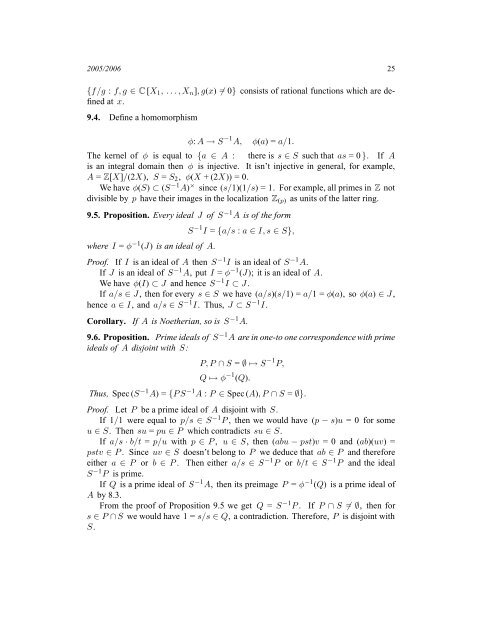Algebra (Unknown 27). - Index of
Algebra (Unknown 27). - Index of
Algebra (Unknown 27). - Index of
You also want an ePaper? Increase the reach of your titles
YUMPU automatically turns print PDFs into web optimized ePapers that Google loves.
2005/2006 25<br />
{f/g : f, g ∈ C [X 1 , . . . , X n ], g(x) ≠ 0} consists <strong>of</strong> rational functions which are defined<br />
at x.<br />
9.4. Define a homomorphism<br />
φ: A → S −1 A, φ(a) = a/1.<br />
The kernel <strong>of</strong> φ is equal to {a ∈ A : there is s ∈ S such that as = 0 }. If A<br />
is an integral domain then φ is injective. It isn’t injective in general, for example,<br />
A = Z[X]/(2X), S = S 2 , φ(X + (2X)) = 0.<br />
We have φ(S) ⊂ (S −1 A) × since (s/1)(1/s) = 1. For example, all primes in Z not<br />
divisible by p have their images in the localization Z (p) as units <strong>of</strong> the latter ring.<br />
9.5. Proposition. Every ideal J <strong>of</strong> S −1 A is <strong>of</strong> the form<br />
where I = φ −1 (J) is an ideal <strong>of</strong> A.<br />
S −1 I = {a/s : a ∈ I, s ∈ S},<br />
Pro<strong>of</strong>. If I is an ideal <strong>of</strong> A then S −1 I is an ideal <strong>of</strong> S −1 A.<br />
If J is an ideal <strong>of</strong> S −1 A, put I = φ −1 (J); it is an ideal <strong>of</strong> A.<br />
We have φ(I) ⊂ J and hence S −1 I ⊂ J .<br />
If a/s ∈ J , then for every s ∈ S we have (a/s)(s/1) = a/1 = φ(a), so φ(a) ∈ J ,<br />
hence a ∈ I, and a/s ∈ S −1 I. Thus, J ⊂ S −1 I.<br />
Corollary. If A is Noetherian, so is S −1 A.<br />
9.6. Proposition. Prime ideals <strong>of</strong> S −1 A are in one-to one correspondence with prime<br />
ideals <strong>of</strong> A disjoint with S:<br />
P, P ∩ S = ∅ ↦→ S −1 P,<br />
Q ↦→ φ −1 (Q).<br />
Thus, Spec (S −1 A) = {P S −1 A : P ∈ Spec (A), P ∩ S = ∅}.<br />
Pro<strong>of</strong>. Let P be a prime ideal <strong>of</strong> A disjoint with S.<br />
If 1/1 were equal to p/s ∈ S −1 P , then we would have (p − s)u = 0 for some<br />
u ∈ S. Then su = pu ∈ P which contradicts su ∈ S.<br />
If a/s · b/t = p/u with p ∈ P , u ∈ S, then (abu − pst)v = 0 and (ab)(uv) =<br />
pstv ∈ P . Since uv ∈ S doesn’t belong to P we deduce that ab ∈ P and therefore<br />
either a ∈ P or b ∈ P . Then either a/s ∈ S −1 P or b/t ∈ S −1 P and the ideal<br />
S −1 P is prime.<br />
If Q is a prime ideal <strong>of</strong> S −1 A, then its preimage P = φ −1 (Q) is a prime ideal <strong>of</strong><br />
A by 8.3.<br />
From the pro<strong>of</strong> <strong>of</strong> Proposition 9.5 we get Q = S −1 P . If P ∩ S ≠ ∅, then for<br />
s ∈ P ∩ S we would have 1 = s/s ∈ Q, a contradiction. Therefore, P is disjoint with<br />
S.

















